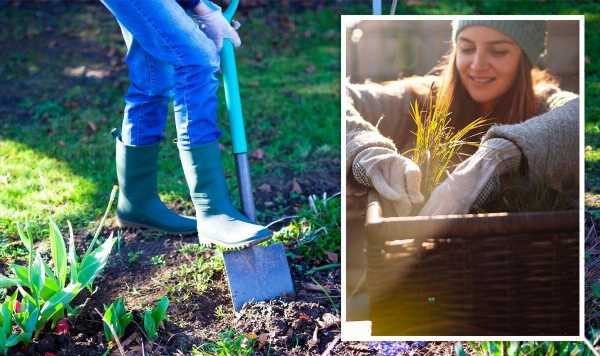Gardeners' World: Monty Don shows how to grow garlic
We use your sign-up to provide content in ways you’ve consented to and to improve our understanding of you. This may include adverts from us and 3rd parties based on our understanding. You can unsubscribe at any time. More info
The autumn and winter months are tough for gardeners, but they can be a great time to start preparing for the sunnier days ahead. Joe Harrison, who shares his gardening experiences and advice on Instagram under the username @grow_with_joe, explained there are “plenty of things to keep you busy” in the garden during the colder seasons.
As well as getting the garden winter-ready, it’s also a good time to plant certain vegetables and plants.
Joe explained: “As another hectic summer season of successionally sowing seeds, watering and harvesting draws to a close, you would be forgiven for thinking autumn is the perfect time for you to relax and do absolutely nothing in your garden. However, there are lots of jobs you can be doing to get ahead and fully prepared for autumn.
“There is garlic to be planted and cold hardy varieties of broad beans to be sown for all those grow your own enthusiasts who want to get ahead for the new growing season next year.”
Garlic is grown by planting individual cloves of garlic (rather than sowing seeds), usually in the autumn months ready for harvest throughout June, July and August.
You can keep your plants safe by covering them with horticultural fleece, which should protect against harsh conditions and deter birds.


While broad beans can be sown right through until April, cold harder versions can be sown in October and November ready for a summer crop.
Joe continued: “Autumn is also the perfect time to plant out those spring flowering bulbs in your beds, pots and borders.”
Currently working as an ambassador for specialist, eco-friendly planter company, Bioscapes, Joe recommends using their WildPod planter for flowering bulbs.
Joe explained: “Be sure to plant your tulip, daffodil and hyacinth bulbs in autumn. You will be treated to a wonderful display of stunning flowers in spring which will be a guaranteed mood booster and a welcome sight after the long damp and dark winter months.”
Even as the cold weather draws in, greenhouses can help with plants that require a little more warmth.
DON’T MISS
‘Genius’ fork hack to hang pictures straight every time [EXPLAINER]
‘Really does work’ – Experts share 99p hacks to get rid of insects [COMMENT]
‘Miracle worker’ – Gardeners share how to clean patios and paths [INSIGHT]

Joe said: “Make use of your cold frames or unheated greenhouses during this time by sowing sweet peas.
“This beautifully fragrant cut flower will benefit from the cool frost-free conditions, which will allow your plants to mature slowly resulting in strong healthy plants.
“These plants will be ready for planting outside in the new year where they will be sure to reward you with your first perfumed bouquet of flowers in early May.”
Autumn is also a good time to protect existing plants you may already have in pots around your garden.
Joe said: “As winter approaches it’s second nature to get ourselves winter-ready. We reach for our big coats, thick scarves, gloves, hats and boots to ensure we are fully prepared to take on all winter has to throw at us, but it can be easy to forget our gardens needs a little attention also.
“Before those winter frosts really bite, spare a thought for all those tender plants which have treated us to such wonderful blooms throughout summers such as dahlias, cannas and gladiolus.

“If grown in pots, you can simply move them into a sheltered frost-free spot. If grown in beds or borders it’s a good idea to lift those tubers or rhizomes so they can be stored in a cool, dry place ready to be planted out in spring so they can flourish once again and treat all who pass by.”
Key jobs to do in the garden in autumn
Sweep and collect fallen leaves. Not only does this keep your garden looking clean, the leaves can also be added to your compost heap and used to give plants a boost next year.
Plant garlic, hardy broadens and spring bulbs, making sure to use appropriate containers and horticultural fleece where necessary.
Make use of your cold frames and greenhouses, planting flowers and vegetables which need a little extra warmth.
Clean and sharpen your gardening tools before storing them for the winter. This will reduce the risk of bacteria build-up and rust over the colder months.
Source: Read Full Article
